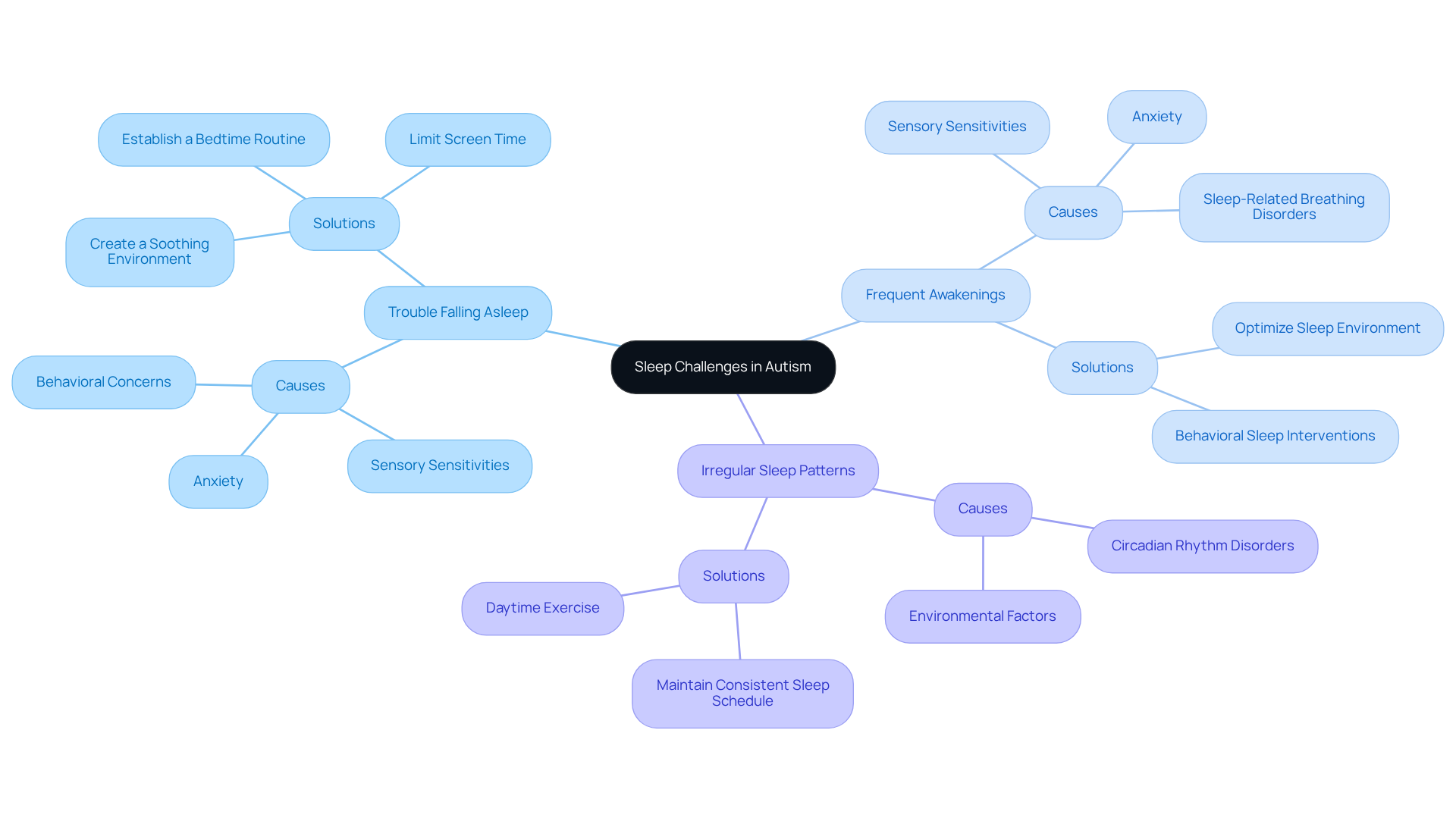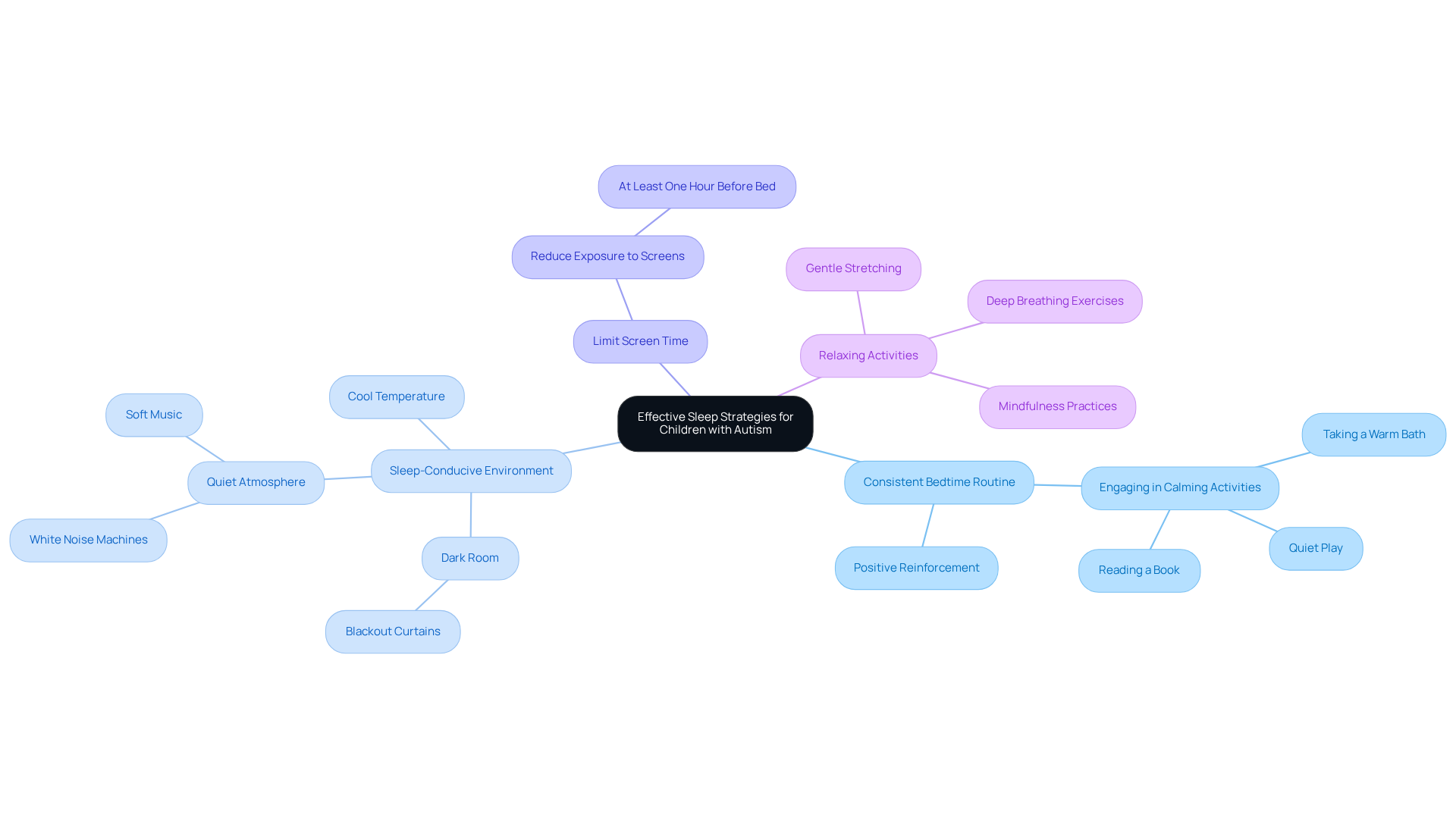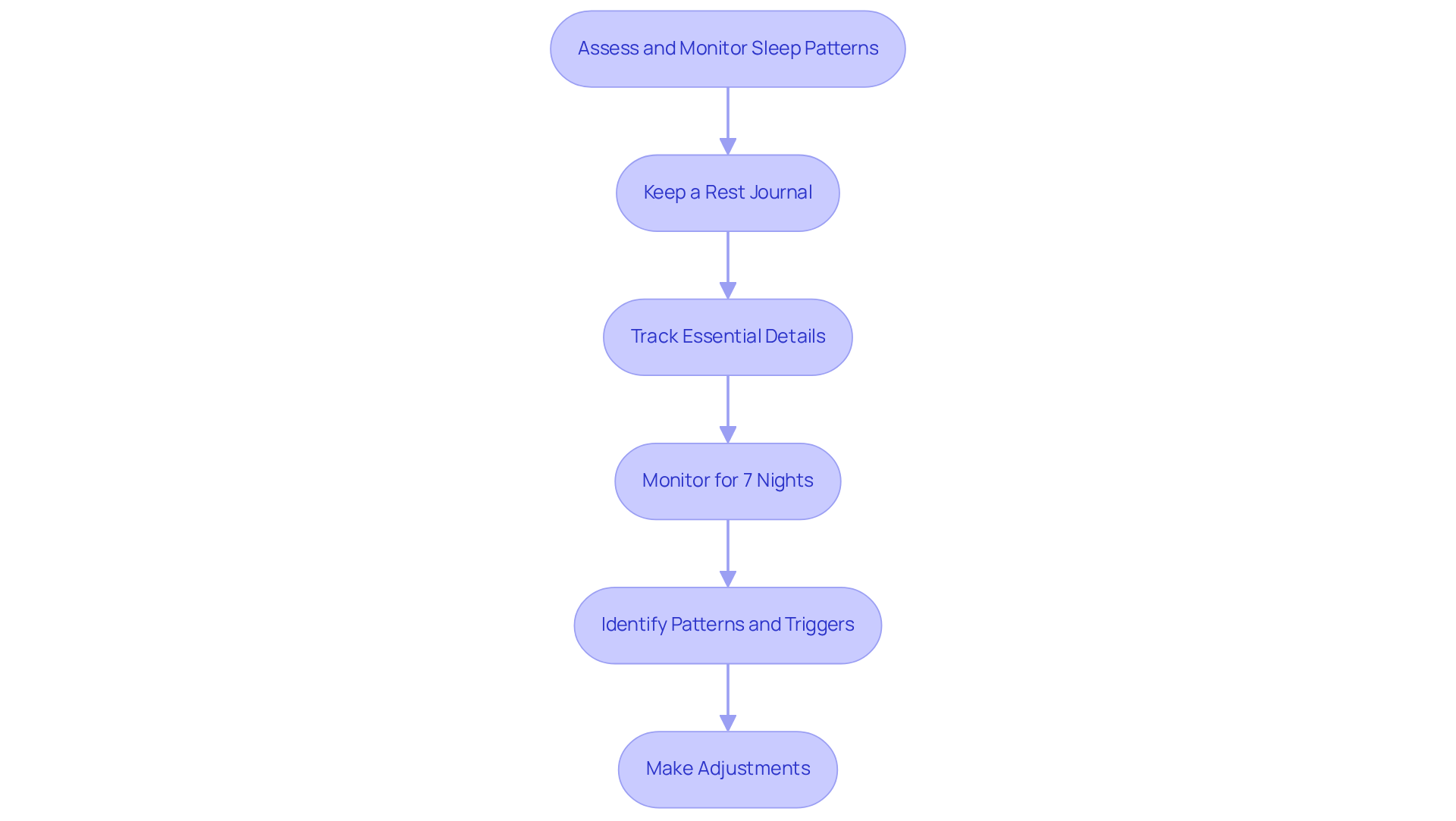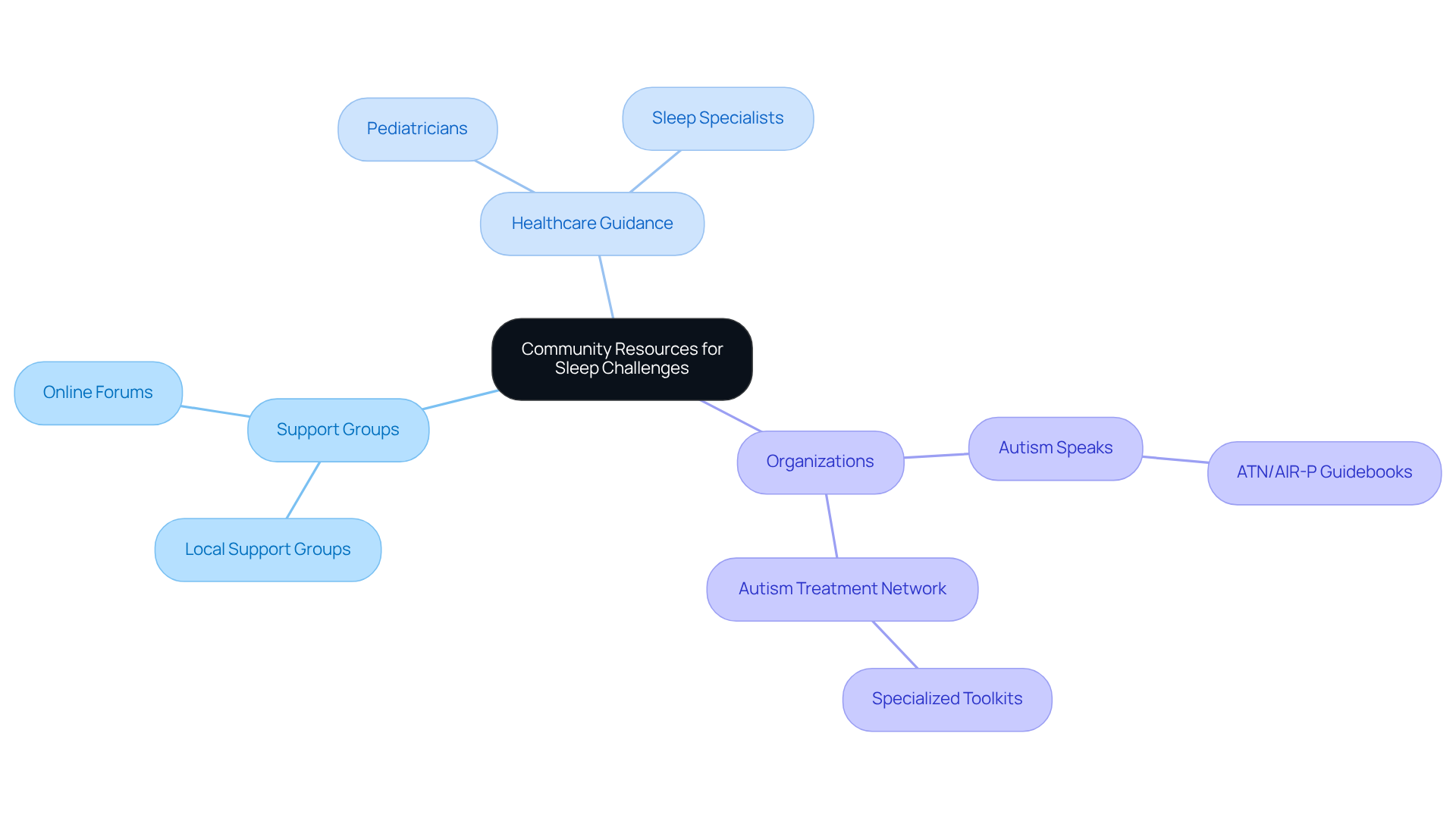Overview
This article highlights vital strategies for enhancing sleep in children with autism spectrum disorder (ASD), addressing the sleep-related challenges that many families encounter. Understanding how crucial a good night's sleep is for both children and their parents, we delve into four key strategies that can make a significant difference. These include:
- Establishing a consistent bedtime routine
- Creating a sleep-conducive environment
- Limiting screen time before bed
- Incorporating relaxing activities
Each of these strategies is backed by research, demonstrating their effectiveness in improving sleep quality and overall well-being for children with ASD.
For parents navigating these challenges, the journey can feel overwhelming at times. However, implementing these strategies can foster a sense of calm and stability in your child's bedtime routine. Imagine a peaceful evening where your child feels secure and ready for sleep, leading to better rest for the entire family.
We encourage you to try these strategies and observe the positive changes they can bring. Sharing your experiences can also be incredibly beneficial; feel free to connect with others in our community who understand your journey. Together, we can support one another in creating a nurturing environment that promotes restful sleep for our children.
Introduction
The intricate relationship between sleep and autism can be a daunting challenge for many families. Studies reveal that up to 80% of children with autism spectrum disorder (ASD) experience sleep difficulties, which can leave parents feeling overwhelmed. This article explores effective strategies designed to enhance sleep quality and overall well-being for these children, offering practical solutions to address common issues such as irregular sleep patterns and nighttime awakenings.
But with so many factors influencing sleep, how can caregivers effectively navigate these challenges to ensure their children receive the restful nights they desperately need? Together, we can find ways to foster better sleep and support our children’s needs.
Understand Sleep Challenges in Autism
Many parents of children with autism spectrum disorder (ASD) may find themselves concerned about sleep and autism, especially when it comes to their child's sleep difficulties. Research indicates that sleep and autism issues can affect as many as 80% of children with ASD, resulting in common challenges such as:
- Trouble falling asleep
- Frequent awakenings during the night
- Irregular sleep patterns
These difficulties often stem from sensory sensitivities, anxiety, and behavioral concerns.
For instance, sensory sensitivities might necessitate adjustments in the sleeping environment. Parents can create a soothing atmosphere by minimizing noise and reducing light exposure, making it more conducive to rest. Additionally, screen time and exposure to violent content can exacerbate sleep problems, highlighting the importance of monitoring these factors closely.
Understanding the challenges of sleep and autism is vital for parents and caregivers. By recognizing the unique needs of their children, they can implement tailored strategies that promote better sleep habits and overall well-being. Recent studies have shown that children with ASD who struggle with sleep and autism tend to exhibit more problematic behaviors than those who sleep well, underscoring the importance of addressing these issues for the benefit of both the children and their families.
Establishing a consistent bedtime routine lasting 20-30 minutes can significantly improve sleep and autism outcomes. This simple action not only helps children wind down but also fosters a sense of security and predictability. Parents are encouraged to share their experiences and strategies, as collective insights can provide valuable support within the community.

Implement Effective Sleep Strategies
To enhance sleep quality for children with autism, parents can implement several effective strategies that truly make a difference:
- Establish a Consistent Bedtime Routine: A predictable routine signals to your child that it’s time to wind down. Engaging in calming activities, such as reading a book, taking a warm bath, or enjoying quiet play, can significantly aid this process. Research indicates that children with autism who follow organized bedtime routines show improved sleep and autism outcomes, leading to reduced daytime irritability and better concentration. As Yitz Diena wisely notes, "Rest hygiene practices, such as establishing a consistent bedtime routine and creating a calming rest environment, are crucial parts of ABA therapy to address these pervasive issues."
- Create a Sleep-Conducive Environment: It’s essential to ensure the bedroom is dark, quiet, and cool. Using blackout curtains can effectively block out light, while white noise machines or soft music can mask disruptive sounds. These modifications address the sensory sensitivities often experienced by autistic children, fostering a more tranquil atmosphere that supports their sleep and autism. Remember, approximately 40-80% of youth with developmental disorders experience sleep and autism-related disturbances, which can exacerbate behavioral challenges.
- Limit Screen Time Before Bed: Reducing exposure to screens at least one hour before bedtime helps minimize stimulation and promotes relaxation. This practice is particularly vital, as children with autism may need more time to transition into sleep and autism compared to their neurotypical peers. Insufficient rest can lead to increased irritability and hyperactivity, highlighting the importance of understanding sleep and autism for fostering better overall behavior.
- Include Relaxing Activities: Gentle stretching, deep breathing exercises, or mindfulness practices can help alleviate anxiety and prepare your child for rest. These activities not only facilitate a smoother transition to sleep but also enhance emotional regulation and behavior throughout the day. As Osman Shabir highlights, "More encouragingly, melatonin supplementation (3-6mg) has also been demonstrated to have a lasting positive impact on rest in youngsters with ASD through modulation of the HPA-axis and serotonin pathways within the CNS."
By applying these strategies, you can significantly improve your child's sleep and autism, both of which are vital for cognitive function, mood stability, and overall well-being. However, it's important for parents to be aware of typical challenges, such as the need to rule out physiological factors contributing to sleep issues before implementing behavioral strategies. Real-life examples, like the story of a child who improved sleep quality through a structured routine, can further illustrate the effectiveness of these approaches. Sharing your experiences or seeking support can also create a sense of community and understanding among parents navigating similar challenges.

Assess and Monitor Sleep Patterns
Keeping a rest journal can be an invaluable resource for caregivers navigating sleep issues with their children. Did you know that 65-83% of autistic children face challenges related to sleep and autism? This diary should capture essential details such as:
- Bedtime
- Wake-up time
- Number of awakenings
- Any notable behaviors during the night
In addition to traditional journals, tracking applications and gadgets can provide helpful insights into sleep duration and quality.
It’s recommended that guardians monitor sleep patterns for at least 7 nights to effectively recognize trends. By consistently reviewing this information, you can identify patterns and triggers that lead to disruptions in sleep. For instance, if your child frequently awakens at a certain hour, consider exploring possible reasons, such as environmental factors or dietary influences. Making necessary adjustments can significantly improve sleep continuity.
Sleep researchers emphasize that observing sleep patterns is crucial for understanding and enhancing sleep quality in young individuals with sleep and autism. This awareness can lead to more effective management strategies. However, it's important to be cautious of excessive reliance on technology or misinterpretation of data, as this could mislead you in your efforts to improve your child's sleep. Remember, you are not alone in this journey, and sharing experiences can foster a supportive community.

Leverage Community Resources and Support
Parents are encouraged to actively seek out community resources to effectively address sleep challenges. Local support groups for developmental disorders and online forums are invaluable platforms where families can share experiences and gain insights from others who face similar issues. Studies indicate that more than half of children on the spectrum experience persistent problems related to sleep and autism. Involvement in these support groups can significantly enhance parents' understanding and management of sleep challenges, with many noting improved techniques after connecting with others.
Additionally, seeking guidance from healthcare professionals, including pediatricians or sleep specialists, is crucial for personalized recommendations and interventions, especially considering that sleep and autism issues reportedly affect as many as 80% of children with ASD. Organizations such as Autism Speaks and the Autism Treatment Network offer specialized toolkits, including three ATN/AIR-P guidebooks designed to improve sleep and autism in children, aimed at assisting families in tackling sleep-related challenges.
Utilizing these community resources not only empowers caregivers but also enhances their ability to support their children's sleep needs, ultimately leading to better health and daytime functioning for both children and their families. As Dr. Beth Ann Malow wisely notes, 'A good night’s sleep is fundamental to all children being able to learn and for their parents to function.

Conclusion
Improving sleep for children with autism spectrum disorder (ASD) is not merely about comfort; it is vital for their overall well-being and development. By focusing on tailored strategies that address the unique challenges these children face, parents can cultivate an environment that promotes better sleep and, in turn, enhances daily functioning. Understanding the complexities of sleep and autism empowers caregivers to implement effective methods that lead to more restful nights.
The article emphasizes several key strategies, such as:
- Establishing a consistent bedtime routine
- Creating a sleep-conducive environment
- Limiting screen time
- Incorporating relaxing activities
These approaches not only assist in managing sleep difficulties but also contribute to improved behavior and emotional regulation throughout the day. Monitoring sleep patterns through journals or tracking tools further aids in identifying triggers and making necessary adjustments, empowering parents to take proactive steps in their child's sleep management.
Ultimately, the journey to better sleep for children with autism is a communal effort. Engaging with community resources, support groups, and healthcare professionals can provide invaluable insights and strategies. By sharing experiences and utilizing available tools, families can foster a supportive environment that prioritizes sleep health. A good night’s sleep is foundational for learning, behavior, and emotional stability, making it crucial for caregivers to take action and advocate for their children's sleep needs.
Frequently Asked Questions
What percentage of children with autism spectrum disorder (ASD) experience sleep difficulties?
Research indicates that sleep issues can affect as many as 80% of children with ASD.
What are common sleep challenges faced by children with autism?
Common challenges include trouble falling asleep, frequent awakenings during the night, and irregular sleep patterns.
What factors contribute to sleep difficulties in children with autism?
Sleep difficulties often stem from sensory sensitivities, anxiety, and behavioral concerns.
How can parents create a better sleeping environment for children with autism?
Parents can create a soothing atmosphere by minimizing noise and reducing light exposure in the sleeping environment.
How does screen time affect sleep in children with autism?
Screen time and exposure to violent content can exacerbate sleep problems, highlighting the importance of monitoring these factors closely.
Why is it important for parents to understand sleep challenges in autism?
Understanding these challenges is vital for parents and caregivers to implement tailored strategies that promote better sleep habits and overall well-being.
What impact does poor sleep have on children with autism?
Children with ASD who struggle with sleep tend to exhibit more problematic behaviors than those who sleep well, making it important to address sleep issues.
What is a recommended strategy to improve sleep habits in children with autism?
Establishing a consistent bedtime routine lasting 20-30 minutes can significantly improve sleep outcomes and foster a sense of security and predictability.
How can parents benefit from sharing their experiences regarding sleep and autism?
Sharing experiences and strategies can provide valuable support within the community, helping parents find collective insights to address sleep challenges.




